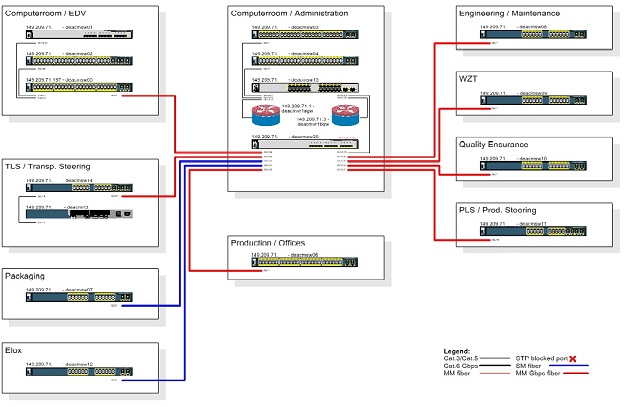|
This page was intended to show some examples of the area I worked in. As soon as I have created some drawings I will of course add these here. The numbers you read about on this page all refer to certain Cisco models. If you operate lots of networks with quite respectable numbers of switches you canít allow to have a zoo of brands and types.
Before you can start to design a network you need to have some information about the requirements upfront, like Where is the biggest network load to find, where are high bandwidth connections needed (connections to servers, high bandwidth using applications like CAD), the requirements for availability and hence the need for redundancy e. g. of connections between switches, the layout of given infrastructure cabling, any EMC issues and of course the number of devices to connect to each and every switch.
The ideal design concept of a network is a star shaped one, where all switches are connected directly to the core switch. If there s a demand for high availability 2 cores can be a solution. Then all switches around have to be connected to both cores, which requires not only quite a number of fiber infrastructure cabling, but also a kind of a backup data center, where all functionality is mirrored. Cascading should be avoided. But I met even the highest requirements by using 3750Gís stacked with one spare as hot standby and a Remote Power Supply RPS, because if anything breaks in a Cisco switch (which is anyway very unlikely), then itís the power supply. Depending on the size of the network and the requirements of availability I used 3560 ( up to +/- 100 nodes ), 3750G ( 800 + (which is my favorite: fast, cheap, stackable) or 4510 ( 1500 +, 6509 used before ) as core switches. Since all distribution switches should be connected to the core switch using copper, single- or multi mode fiber, the later one is required to have a sufficient number of ports and the appropriate SFPs/GBICs (LX/LH or SX/SH mostly). The use of media converters should be avoided; most of them are not manageable meaning, that you can not see interface problems, they come with their own power supply ( which can break ) and the connections they carry need special attention in the monitoring if used in scenarios with redundant connections. Some customers tend to try to save money, so You have to cascade switches (might be ok depending on the load and the need of availability), but then You start to establish redundant connections, which involves Spanning Tree and the problems coming along with it.
It is always a good idea to separate the production network from the office network, since the equipment - servers and PCs - in the production need to be up and running 24/7 and therefore can not be updated and hardened on a regular bases as you can do with office servers and PCs. Even this makes routing a bit complicated, requires setup of DHCP relay, a firewall or at least a port based filtering router in between may be doing NAT as well, I always recommend this. Customers asked to keep their solutions, so beside the company standard (which was Nokia with Checkpoint SW) I had to deal with a number of other kind of firewalls and routers. But this doesnít necessarily mean, that it has to be a physically separated network, the separation can easily be done by the usage of VLANs. All named cores ( s. a. ) are capable of inter-vlan-routing.
Our main industry customer ordered us to migrate all of his sites to one corporate standard design. So I replaced lots of equipment by Cisco hardware, but it also happened a lot, that I had to life with the customer provided hardware. This led to a broad variety of brands and types of devices, which I also operated.
Below you find a rather small and quite clean network, since I had to replace all components and therefore had the chance to create a new design and implement it accordingly.

If You like to hear more details, please let me know:
eberhard@eschiebler.de.
|

